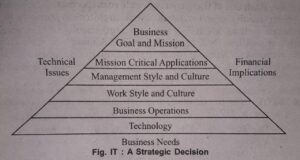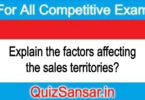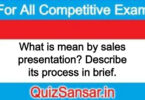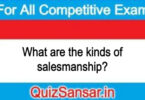
How could a business firm use internet technology to form a virtual company and becoming an agile competitor ?
How could a business firm use internet technology to form a virtual company and becoming an agile competitor ?
Ans.
Strategic Uses of Information Technology: Information technologies can support many competitive strategies. They can help a business cut costs, differentiate and innovate in its products and services, promote growth, develop alliances, lock in customers and suppliers, create switching costs, raise barriers to entry, and leverage its investment in IT resources. Thus, information technology can help. a business gain a competitive advantage in its relationships with customers, suppliers, competitors, new entrants, and producers of substitute products. Refer to Figures 2.3 and 2.5 for summaries of the uses of information technology for strategic advantage. in supporting innovative changes in the design of workflows, job requirements, and organizational structures in a company.
Becoming an Agile Company: A business can use information technology to help it become an agile company. Then it can prosper in rapidly changing markets with broad product ranges and short model lifetimes in which it must process orders in arbitrary lot sizes, and can offer its customers customized products while maintaining high volumes of production. An agile company depends heavily on Internet technologies to help it be responsive to its customers with customized solutions to their needs and cooperate with its customers, suppliers, and other businesses to bring products to market as rapidly and cost-effectively as possible.
Creating a Virtual Company: Forming virtual companies has become an important competitive strategy in today’s dynamic global markets. Internet and
Building a Customer-Focused Business: A key strategic use of Internet technologies is to build a company that develops its business value by making customer value its strategic focus. Customer-focused companies use Internet, intranet, and extranet e-commerce websites and services to keep track of their customers’ preferences; supply products, services, and information anytime, anywhere; and provide services tailored to the individual needs of their customers.
Reengineering Business Processes: Information technology is a key ingredient in reengineering business operations by enabling radical changes to business processes that dramatically improve their efficiency and effectiveness. Internet technologies can play a major role other information technologies play an important role in providing computing and telecommunications resources to support the communications, coordination, and information flows needed. Managers of a virtual company depend on IT to help them manage a network of people, knowledge, financial, and physical resources provided by many business partners to quickly take advantage of rapidly changing market opportunities.
Building a Knowledge-Creating Company: Lasting competitive advantage today can only come from innovative use and management of organizational knowledge by knowledge-creating companies and learning organizations. Internet technologies are widely used in knowledge management systems to support the creation and dissemination of business knowledge and its integration into new products, services, and business processes.
A business enterprise or an organization requires to make a decision of choosing an appropriate Information Technology (IT), as a vehicle, to handle the management information system. The choice of IT is a strategic decision, making long-term impact on the effectiveness of the MIS of the enterprise. The information technology affects the people, the processes and the productivity of the organization. It is a strategic business decision and not a financial decision to be taken on the least cost approach.
Just as the MIS handles the decision support applications, the choice of the Information Technology makes a qualitative difference in the decision making process. Hence, a wrong choice of the IT would kill a good MIS design as the information technology would not support the user on the aspects and the requirements such as speed, response, access, security, autonomy and integration of the information processing on the different hardware software platforms.
A wrong choice of the information technology would also kill the MIS designer’s ability to develop a user-friendly end user computer system, providing all capabilities of the data and the information handling with flexibility and speed.
The choice of information technology can be compared to a decision of constructing a house. Though the cost of construction is a major decision parameter, many other factors such as the living comfort and convenience, accommodation of the family members with their respective living styles, etc. are equally important. Besides a house should have a privacy, should be aesthetic to look at, airy and well lit and also the maintenance of facilities and utilities should be easy. A wrong choice of house, therefore, affects the buyer for the lifetime, both, in terms of the cost and also in terms of comfort. The decision is usually irreversible and very costly, arid may not satisfy all the needs of the members of the family.
The modern information technology offers a number of different system configurations, each being a candidate, as a solution to satisfy the needs of the MIS. The information technology decision, therefore, is a technical decision, where it is required to decide between the various configuration alternatives made of a variety of hardware and software options. The configurations are the LAN or the WAN, the Mini or the Supermini, and the Front end and the Back Office Systems, Internet/ Intranet, OOT, Client Server Systems.
The configurations could be evolved on the basis of the approach to the information processing. It could either be distributed or centralised, local processing or centralised processing, etc. It could be a conventional data processing approach versus the database management approach.
Each configuration has certain technical merits and demerits, and, therefore, has to be weighed on some other criteria for its selection. Each one of them covers a wide cost spectrum. The wide cost spectrum results due to the different architecture options in the hardware such as the RISC, the CISC and the different processing chips such as the INTEL, the MOTOROLA or the PROPRIETARY Chip such as the ‘Alpha’ of the Digital and the POWER PC of the IBM, etc.
The third reason is the different operating systems for the different platforms, i.e., the DOS, Windows NT, the UNIX, the OSF, the MOTIF, the OS2, the VMS and their proprietary versions such as the Ultrix, the HP UNIX, and the ORG UNIX, etc.
The information technology decision is also influenced by people-related factors. The choice of the information technology is made on the basis of the ability of the people in the organization to run the hardware software system. The place like warehouse may not have highly qualified computer literate personnel and, therefore, at such a location, PC systems would be an automatic choice or a dumb terminal of the main computer system. But at the factory location, since the personnel are of the higher skills, grade and qualifications, a Network or a mini system, capable of offering different software solutions, would be required. In such a place, hardware and soft- rare support in also required.
Though training the personnel to become computer literates is a solution to such problems, it may not be always possible and operationally feasible to solve such problems and give a hightech information technology solution which is uniform across the organization. The work culture and the people culture become the critical decision inputs for any information technology decision.
Finally the information technology choice is governed by the requirement of the mission critical application(s) of the organization. The hardware choice, and its configuration in terms of memory, disk and communication are decided on the base of processing needs of the mission critical applications. The other requirements of the organization are to be fitted to this configuration.
For example, if the main business of an organization is service to the customer, then the mission critical application is the inventory management of a variety of items manufactured and distributed at different locations. Such an application would need resource sharing at different locations of hardware, software and databases. It could be a case of sharing between the UNIX DP network and the minis with a different DBMS systems. The sharing of each other’s resources may be for input acquisition and processing for integrating the data on a higher plane and sending the results to different locations, and for presenting on the different output devices such as the laser printers. and plotters, and also on the storage devices available at the different locations.

The information technology decision is made for the current needs as well as for the futuristic needs of the organization. Hence, the decision is influenced by the technology forecast and the business forecast. It requires some valid assumptions about the growth of the business, the manner in which it will be conducted and the information needs of the organization to conduct the business. Such a probing in the futuristic needs helps to size up the various options and to weigh them critically on the various criteria.
The information technology decision, therefore, is a decision to be taken at a particular point of time and implemented over a period of time considering the various soft and hard options experienced from time to time. If the organization is under a financial pressure as the budget is not adequate to implement the best information technology option, then the information technology opted for should be upgradable, expandable and scalable. Such organizations can start with a smaller configuration and migrate to a bigger one with no risk of technological obsolescence or no loss of development effort.
The nature of IT decision is complex and is governed by a number of factors as shown in Fig. Since, this decision has long-term business and financial implications and affects the entire organization, it is a strategic decision.
The information needs of the people in the organization arise from the process or the style by which the management ‘runs’ the business. The quality of management process depends on the people culture and the culture predominantly affects the decision making process.
If the decision processes are centralised at a higher level and the delegation of responsibilities and authorities is not proper, then the information technology choice will weigh, heavily in favour of the distributed data acquisition systems and the centralised high end information processing systems for decision support.
If the decision processes are decentralised, the information technology choice will weigh in favour of those systems, where the acquisition, processing, analysis and decision making will be at distributed nodal points. The organization which operates through number of locations and on the basis of the Strategic Business Units (SBU), will opt for such an option. In such cases the typical nature of the concerned SBU will decide the hard ware-software platform for the particular unit at the particular location.
If the decisions in the organization are of the following types, then the information technology options would differ. These types are:
(a) The decisions affecting the operations management.
(b) The decisions affecting the execution and control of the business.
(c) The strategic business decisions.
In such cases, the information technology choice would be the Front End Processing System connected to the Back Office Central System. Hotels, hospitals and a large operate bodies are the examples, where such a choice is desirable. The front end systems take care of the operations management, while the back office systems take care of the strategic and the operations planning and control of the business.
There are other business situations where due to sensitive nature of the business, decision making is concentrated at one business location or in one of the business functions such as marketing, research and development, manufacturing, etc. The information technology choice is largely governed by the information needs of that particular location or function. In other words, every business has one or more mission critical applications serving the information needs of the critical strategic decisions. The entire management process revolves around these applications. The organizations’ information technology choice is, therefore, based on the requirement of these applications serving the critical business functions.
Due to the organizations’ infrastructure and also due to the nature of the business it so happens that there are data centres, where a large number of transactions take place and these are the decision centres. In such cases the information technology choice will be in favour of the distributed high end data processing systems and the dedicated information processing systems at the decision centre using the distributed data bases. Many service oriented businesses like the banks, the insurance companies, etc. fall into this category.
This is how a firm can use IT to form a virtual company and becoming an agile competitor.






